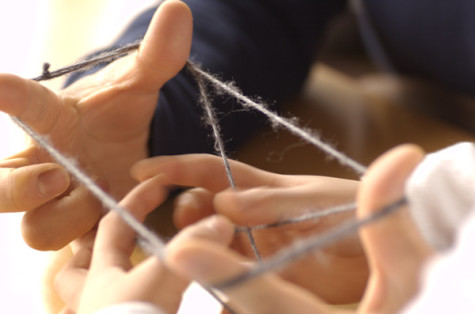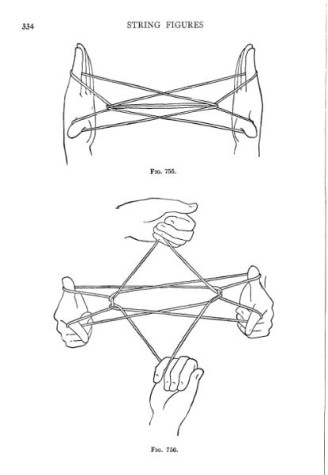 I often buy presents for my kids that are really for me. This time, it was a special string for doing Cat’s Cradle. (Of course, it’s funny that I even bought a string, instead of tying a piece of yarn into a loop like I once did.)
I often buy presents for my kids that are really for me. This time, it was a special string for doing Cat’s Cradle. (Of course, it’s funny that I even bought a string, instead of tying a piece of yarn into a loop like I once did.)
When they unwrapped it, they saw a rainbow piece of silk, one solid knotless loop. This is a loose rendering of the conversation that followed:
Oldest son: “What is this?”
Me: “It’s a game.”
OS [disappointed]: “Oh.”
Middle son is about to throw a tantrum. Enter Grandma.
Grandma: “Oh! Cat’s Cradle! How fun!”
I looped the string around my fingers and my mom and I went through the familiar patterns. The cradle, the soldier’s bed, the candles, the manger, the diamonds, the cat’s eye and back again. The boys watched, apparently fascinated, although I’m not sure if they were entranced by the patterns or by the way both their mom and grandma were so focused on this little piece of string.
These kinds of games have been passed down through generations in cultures all over the world. From the Arctic to Australia, from Africa to the Andes, people have been making string figures—whether to tell stories or just to play—for a very long time.
The earliest writing we have about string figures comes from a Greek, Heraklas, in about 100 BCE—who explains that the figure, called plinthios, can be used to help straighten a fractured chin. These days, several museums have collections of string figures, including the British Museum, which has eight figures from an 1888 expedition to the Torres Strait, a shallow, island-dotted waterway between Australia and Papua New Guinea.
The ethnographer who collected these string figures, Alfred C. Haddon, went on to seek out more string figures and to develop a way to describe them, which he published with a colleague in 1902. Anthropologists later used many of the terms he came up with to talk about string figures from around the world. While often seen as play, string figures also became part of rituals and local lore; in many Arctic societies, string figures were encouraged during long dark winters, but prohibited in the sunlight, as they were thought to interfere with the sun’s rising.

Those who studied string figures also wondered about the figures’ connection with mathematics. Over the years, several mathematicians have looked at the properties of particular figures. Eric Vandendrissche, who studied string figures in Papua New Guinea and in Paraguay, wondered why the experts he met in these places rarely wanted to (or could) create brand-new figures.
In a recent paper, he talks about the work of Thomas Storer, a mathematician who had learned string figures from his grandmother and friends. Storer, one of the first native Americans to earn a PhD. in mathematics, focused on the “heart sequence” of string figures—looking at the loop that is passed over the hands and following the movement of this loop, without looking at the motions of how the fingers work to make this happen—and turning this into mathematical formulas. In a recent paper, Vandendrissche uses this method to compare certain patterns of final figures that are made in different ways in different cultures, but arrive at the same final patterns through only two different “heart sequences”.
After I uncovered the forgotten strings in a drawer yesterday, I tried to learn a few new tricks to impress my kids. But just making the patterns seemed almost as complex to me as trying to piece out some of these formulas.
Then I came across the website of James Murphy, a former high school teacher who started teaching the string figures he’d learned as a kid to the students in his math classes. Learning these figures, he says, helped with complex problem solving, and forging connections between the hands and the brain that can be applied again and again. (It’s also fun, and confidence-building—portraits of some of his smiling students and their creations can be found here.)
Following Murphy’s videos, I worked on learning the patterns of diamonds that lead to Jacob’s Ladder, a figure that appears in many cultures, and has also been called Osage Diamonds, or Fishnet. My husband laughed at me as he did the dishes and I sat there, peering at the phone and then my hands. He made polite sounds as I showed off the various figures: one diamond, two diamonds, three diamonds, and the ladder. He is used to sudden, strange enthusiasms; he kept washing the dishes.
Flush with success, I left the outstretched ladder for my son to see when he came into the kitchen for breakfast. This morning, I asked him if he’d seen it. “Yeah,” he said. “Do you want me to teach you?” I asked, later. He shook his head.
I’ll try him again in a few weeks. In the meantime, maybe I’ll just show the person who will always care: my mom.
**
Top image
Daisuke Matsumura, via Flickr/Creative Commons